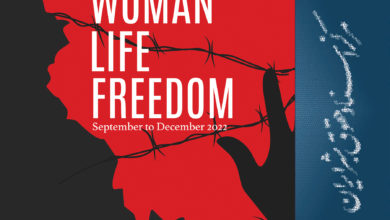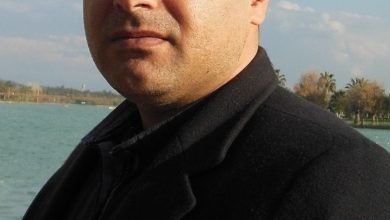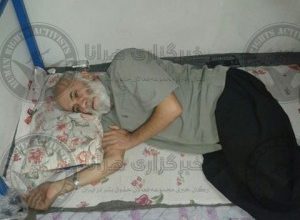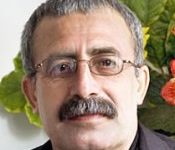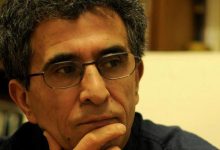Witness Statement of Mala’ekeh Alamhooli
Name: Mala’ekeh Alamhooli
Place of Birth Deym Gheshlagh, Maku, Iran
Date of Birth August 5, 1979
Occupation Civil Rights Activist
Interviewing Organization: Iran Human Rights Documentation Center (IHRDC)
Date of Interview: February 7, 2012
Interviewer: IHRDC Staff
This statement was prepared pursuant to a telephone interview with Mala’ekeh Alamhooli. The statement consists of 23 paragraphs. The statement was approved by Mala’ekeh Alamhooli on February 29, 2012 and June 8, 2012
The views and opinions of the witness expressed herein do not necessarily reflect those of the Iran Human Rights Documentation Center.
Background and Arrest of Shirin Alamhooli
1. Shirin Alamhooli was born on June 3, 1981 in Deym Gheshlagh village near Maku, Iran. Ms. Alamhooli joined PJAK, also known as the Party of Free Life of Kurdistan in 2006. She got involved in civil rights and political activism within Iran.
2. She was not an armed [member of PJAK]. Even when the plainclothes agents of IRGC arrested her on April 28, 2008, she was not armed.
3. She herself writes in a letter discussing her suffering in detention [that was smuggled out of prison] that after being arrested on a street in Tehran by the IRGC she was taken directly to the IRGC headquarters.
4. She clearly states in her letter that she was arrested by the IRGC on a street in Tehran and was directly sent to the IRGC headquarters. This torture letter is documented in her files [as compiled by the government].They detained her in the IRGC headquarters for 25 days and all the forms of physical and mental torture exerted on her are explained in the letter.
Detention of Shirin Alamhooli
5. She went on dry hunger strike (refusal of both food and water) for 22 out of these 25 days. She also points out that they tried to break her strike numerous times. Her interrogators put a feeding tube in her nose [a process known as nasogastric intubation] in order to force a liquefied nutritional mixture into her stomach. She resisted and took out the feeding tube by force and that caused severe bleeding. Even after she was sent to ward 209 and later the women’s ward of Evin prison, the wounds in her nose and esophagus were not healed and they caused her much pain.
6. She writes that she was chained up, hit with batons, kicked, and tortured with hot and cold water. She says they hit her legs and feet with cables so much that she couldn’t stand up. Ms. Alamhooli’s attorney pointed out these [examples of torture] and so did her inmates. Even her family saw the scars and effects of torture on her when they went to see her. [Women’s rights activist] Ms. Khadijeh Moghadam says that “It was very difficult to [look at] her [injured] feet; it was shameful how much torture she had undergone. You didn’t dare to look at her feet.” Even some of her cellmates like Ms. Silva Hartunian say that when she was brought to Evin Prison, she was nothing but “a bunch of bones covered in skin.” Ms. Alamhooli said that they kicked and stomped on her feet and nails so much that her nails turned black and fell off. She added that she was tortured so much that she suffered from trauma and nightmares and fainted as a result of extreme torture. She said that one of the interrogators, the only one whose face she saw, told her that they knew who [what kind of person] she was, and that they would be very happy if she kept on refusing to say anything [so as to justify continued torture]. She added that he offered her a cigarette but didn’t give it to her; instead, he put out his cigarette on her hand. Her inmates and her lawyers recounted these things, and she further confirmed them herself in the letters that she sent out.
7. After those 25 days of torture in the IRGC headquarters, she was transferred to ward 209 of Evin Prison, which belongs to the Ministry of Intelligence. She was subjected to the most violent physical and mental torture there for 6 months. When Shirin was arrested, Basirat magazine—a publication linked to the IRGC—announced that they [the IRGC] had arrested a spy for the US that had entered the country to carry out bombings. We heard the news about Shirin’s arrest in Kurdish-language media. A little while later PJAK released a statement announcing that Shirin Alamhooli was a member of their organization, but strongly rejected the espionage allegations. They also announced that they considered the government responsible for anything that might happen to her. We learned about her arrest that way, and then no matter how much the family and relatives tried to find her, the organizations and authorities said they knew nothing about her [whereabouts].
8. The family didn’t know where they had taken Shirin and what they had done to her until she was transferred to the women’s ward of Evin Prison from ward 209 six months later [after her transfer to ward 209 from the IRGC headquarters]. Her family only heard about her detention in Evin Prison a short while before she was transferred to the women’s ward. She had visits with her family in the women’s ward and [also] told her attorneys Mr. Fereydoun Shaami and Mr. Khalil Bahramian what happened to her. Even in the final days, a week before she was executed, she noted in a letter that her eyesight had seriously degenerated. She asked for glasses but they did not respond to her request. The progressive weakening of her eyesight was due to the physical and mental torture she endured, which also caused fainting spells. In addition, her hair started to go white prematurely.
Prosecution
9. When Shirin Alamhooli was arrested, the police had no evidence against her. Judge Salavati of Branch 15 of the Revolutionary Court of Tehran charged her with Muharibih (waging war against God)—by virtue of having illegally crossed the border—and collaboration with PJAK.
10. Her father, mother and brother visited her a couple of times, once during Norouz [Iranian New Year] and once almost a week before she was transferred to the women’s ward of Evin Prison. They called the family and told them that Ms. Shirin Alamhooli was in Evin Prison and wanted to visit with them. Aside from those two times, no one [in the family and among her friends] visited her. She was detained and imprisoned for two years and 13 days until she was executed. Almost for one year, no one in her family knew where she was or [even] whether she was alive. They didn’t give out any information. After that Mr. Fereydoun Shaami became her attorney and was joined by Mr. Khalil Bahramian in her defense.
11. On December 19, 2009 in Branch 15 of the Revolutionary Court of Tehran presided over by Judge Salavati she was sentenced to two years’ imprisonment for illegal border crossing. She was sentenced to death on the charge of Muharibih through cooperation with PJAK, after a trial that lasted a few minutes, wherein she was not allowed to defend herself. She [originally] had a court-appointed attorney and then in her first hearing her attorney was Mr. Shaami.
12. When she was sentenced to death her attorney Mr. Shaami appealed the sentence. He insisted that the sentence for the charges against Shirin could be exile or imprisonment, not the death sentence; because of that Mr. Shaami wrote the appeals in a way that would draw the attention of the Supreme Court and cause them to pick the case up, [but] they didn’t allow the case to go to the Supreme Court from Branch 15 of the Revolutionary Court. Hence ultimately they only tried her for a few minutes and then they made promises and everybody was waiting for the Supreme Court to make a decision. Finally they executed her without [the Supreme Court] approving or disapproving. Ms. Alamhooli was born in the remote village [of Deym Gheshlagh] near the suburbs of Maku but she managed to pursue her studies. That doesn’t mean she didn’t know Farsi and was illiterate and didn’t know anything. These are all accusations made by the Islamic Republic.
13. When she was arrested she was not very fluent in the Persian language. But ideologically, she was a sophisticated and well-trained girl. In fact, Judge Rahmatian said that the reason she received the death penalty was because she was wise, sharp, and a fighter. It is true that when Ms. Alamhooli was arrested she was not fluent in Persian, notably [she was not fluent enough] to defend herself in the court.
14. During her imprisonment, Ms. Alamhooli was able to obtain a fifth grade certificate. Even the night that they took her away to be executed, her inmates point out that she was studying for the exam that she had the next day. She also took a number of courses such as computer science, weaving, and pottery. The completion certificates are available.
15. When the Islamic Republic has left no other option for the people and nations to obtain their rights and people do not have any rights, the people and the freedom fighters pursue those rights in other ways. Ms. Alamhooli was one of those fighters. She planted a bomb in the yard of the IRGC headquarters. The Islamic Republic is engaged in propaganda and says that the bomb was in a university and around civilians. This propaganda is false and is not real in any way. The bombing was in the yard of the IRGC headquarters and harmed no civilians.
16. Such a person should not be given such a verdict. We were waiting for the case to be sent to the Supreme Court, but unfortunately her case was never sent to the Supreme Court. At that time Mr. Khalil Bahramian called Branch 15 of the Revolutionary Court and they told him that they had decided to send Ms. Alamhooli’s case to the Supreme Court. Mr. Shaami and Mr. Bahramian announced that it had been sent to the Supreme Court. Later when Mr. Shaami went and asked the court about the case, they told him that the case had not been sent to the Supreme Court after all, and that it was still in their hands.
Execution
17. After 7 days in solitary confinement, Ms. Alamhooli was executed on May 9, 2010 without the knowledge of her attorney[s], or family and even without being given permission to say goodbye to her cellmates. This occurred one year and nine months after she was transferred to the women’s ward of Evin Prison. She was executed with four other political activists in Evin Prison.
18. We can’t go to Iran [anymore] and the families were not aware [anyway]. I was the first person outside Iran to see the news on the websites like IRNA and Fars News at seven in the morning. They wrote that five people had been executed and that Ms. Shirin Alamhooli was one of them. Then I called her family, who were not expecting to hear the news of her execution at all. We did not expect it because the case had not been sent to the Supreme Court to be confirmed or overruled. It means that by executing this political activist, the Islamic Republic proved that it does not even respect the law and the rules that they have set for themselves. Among the other four political activists, one was a Persian activist and the other three were Kurdish political activists (Farzad Kamangar, Farhad Vakili, Ali Heydarian and Mehdi Eslamian). They were executed in the yard of Evin Prison.
Mala’ekeh Alamhooli
19. I haven’t been able to go to Iran for a long time. I am only two years older than Shirin. We grew up together. We grew up in the same extended family, but I left Iran 7 or 8 years before her [execution]. I live abroad; I left Iran due to political reasons. I grew up in a family that could not tolerate all the poverty, hunger, murders, tortures and even prostitution that went on in the region, where the system of the Islamic Republic acts against the Kurdish people, girls, women and the youth. Wherever such a feudalistic structure rules society, you will finally start to think about these wrongs at some point. I saw those wrongdoings and had to choose a path. I had to accept what the Islamic Republic had encouraged traditional patriarchal life, but I could not accept these things and found a new perspective for myself and decided I wanted to leave Iran.
20. When I left Iran, Shirin Alamhooli was a child. She was two years younger than me and was almost 16 when I left. She was younger than me, but kept up her resistance [to the government] despite the torture, imprisonment and pressures to which she was subjected.
Family
21. [The family of Ms. Alamhooli was] not political at all, but political [activism] is very much accepted in that area [Iranian Kurdistan]. She grew up in a region where society was politicized. Maku is a border city, and from an economic standpoint, the people [who live there] are poor. They earn most of their income from border crossings and [illegal] trade on both sides of the border. The activities and activists there who are in touch with people like Ms. Alamhooli, her family and other Kurds, have an impact and [as a result] most people are familiar with the political culture there. In other words the oppressed people of that region are raised like that. They talk to each other about their rights. Shirin was raised in that atmosphere as well. No one else in her family was engaged in politics. She was the first in her family to engage in resistance and political activism. The other (siblings) were too young to be able to get into politics. Ms. Alamhooli was the eldest daughter—the eldest child of her family.
22. I want to talk about the execution of Ms. Alamhooli. As a large Iranian family, we [Iranian citizens] are currently living in hardship and are suffering these executions and torture that exist in Iranian prisons. We should resist and live life, because life without resistance is impossible.
23. I just want to mention another point and that is the fact that they did not give back the bodies of Ms. Alamhooli and her friends [the other four prisoners who were executed with her] to their families. Apparently, when they executed them, they told the families that they would give the bodies back to the families, but they didn’t. Then they told the families that they would bury them and would tell the families to go visit the graves after a week. They didn’t even do this, and there is as of yet no information about where they were buried. They have not responded to the families. The families are still waiting for the bodies of their children so that they can have [marked] graves and hold a ceremony, but unfortunately two years after the executions the Islamic Republic has refused to give the bodies to the families. Her family called and attempted to retrieve the body several times, but they didn’t give them the body. So far there is no news regarding their bodies. They have not responded to her family’s questions. To this day, all the families, including Ms. Alamhooli’s, are waiting to get the bodies of their loved ones.


